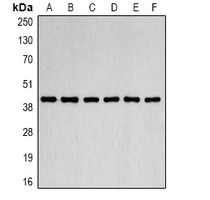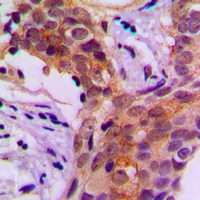Description:Mouse monoclonal antibody to Beta-actinImmunogen:Recombinant protein corresponding to human Beta-actin.Purification:Affinity chromatographyClonality:MonoclonalForm:Liquid in 0.42% Potassium phosphate, 0.87% Sodium chloride, pH 7.3, 0.2% BSA, 30% glycerol, and 0.01% sodium azide.Dilution:WB (1/3000 - 1/10000), IH (1/50 - 1/100), IF/IC (1/50 - 1/100)Gene Symbol:ACTBAlternative Names:Actin cytoplasmic 1; Beta-actin
Entrez Gene (Human):
60;
Entrez Gene (Mouse):
11461;
Entrez Gene (Rat):
81822;
SwissProt (Human):
P60709;
SwissProt (Mouse):
P60710;
SwissProt (Rat):
P60711;
Storage/Stability:Shipped at 4°C. Upon delivery aliquot and store at -20°C for one year. Avoid freeze/thaw cycles.
-
 Western blot analysis of Beta-actin expression in Jurkat (A), MCF7 (B), NIH3T3 (C), mouse brain (D), rat brain (E), COS7 (F) whole cell lysates. (Predicted band size: 41 kD; Observed band size: 42 kD)
Western blot analysis of Beta-actin expression in Jurkat (A), MCF7 (B), NIH3T3 (C), mouse brain (D), rat brain (E), COS7 (F) whole cell lysates. (Predicted band size: 41 kD; Observed band size: 42 kD) -
 Immunohistochemical analysis of Beta-actin staining in human prostate cancer formalin fixed paraffin embedded tissue section. The section was pre-treated using heat mediated antigen retrieval with sodium citrate buffer (pH 6.0). The section was then incubated with the antibody at room temperature and detected using an HRP conjugated compact polymer system. DAB was used as the chromogen. The section was then counterstained with haematoxylin and mounted with DPX.
Immunohistochemical analysis of Beta-actin staining in human prostate cancer formalin fixed paraffin embedded tissue section. The section was pre-treated using heat mediated antigen retrieval with sodium citrate buffer (pH 6.0). The section was then incubated with the antibody at room temperature and detected using an HRP conjugated compact polymer system. DAB was used as the chromogen. The section was then counterstained with haematoxylin and mounted with DPX. -
 Immunofluorescent analysis of Beta-actin staining in A549 cells. Formalin-fixed cells were permeabilized with 0.1% Triton X-100 in TBS for 5-10 minutes and blocked with 3% BSA-PBS for 30 minutes at room temperature. Cells were probed with the primary antibody in 3% BSA-PBS and incubated overnight at 4 °C in a humidified chamber. Cells were washed with PBST and incubated with a DyLight 594-conjugated secondary antibody (red) in PBS at room temperature in the dark. DAPI was used to stain the cell nuclei (blue).
Immunofluorescent analysis of Beta-actin staining in A549 cells. Formalin-fixed cells were permeabilized with 0.1% Triton X-100 in TBS for 5-10 minutes and blocked with 3% BSA-PBS for 30 minutes at room temperature. Cells were probed with the primary antibody in 3% BSA-PBS and incubated overnight at 4 °C in a humidified chamber. Cells were washed with PBST and incubated with a DyLight 594-conjugated secondary antibody (red) in PBS at room temperature in the dark. DAPI was used to stain the cell nuclei (blue).
Expanding potential targets of herbal chemicals by node2vec based on herb–drug interactions
Integrative pharmacology reveals the mechanisms of Erzhi pills, A traditional Chinese formulation, stimulating melanogenesis
Dual-Responsive Renal Injury Cells Targeting Nanoparticles for Vitamin E Delivery to Treat ischemia reperfusion induced Acute Kidney Injury
PPARγ-mediated amelioration of lipid metabolism abnormality by kaempferol
Journal
Archives of Biochemistry and Biophysics
IF
3.8
Application
WB
Reactivity
Human
PMID
39278305
Oleanolic acid attenuates obesity through modulating the lipid metabolism in high-fat diet-fed mice
Mechanism of HIF-1α promoting proliferation, invasion and metastasis of nasopharyngeal carcinoma by regulating MMP-8 in hypoxic microenvironment


 Datasheet
Datasheet MSDS
MSDS